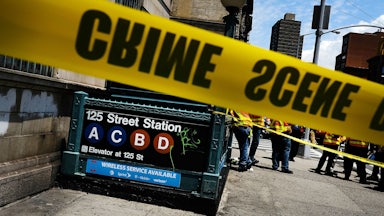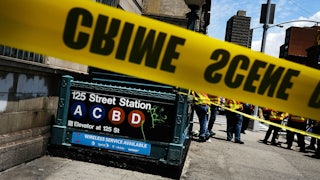Amid doe-eyed stories of overwhelmed police engaging in walkouts and a rash of angry op-eds about underfunded police departments leading to waves of violent crime, the market for new police gadgets and gizmos is quietly booming. “Agencies are buying new technology, boosting efficiency and enabling new types of reporting,” Government Technology magazine recently reported: Mark43, a law enforcement software company, just raised $101 million in venture capital funding. And if municipalities don’t want to pony up for the latest devices, they can apply for one of many grant opportunities out there. Axon, the Taser-maker, recently produced a webinar about how to fill in budgetary gaps with “other sources of capital.” Axon has also given out its police body cameras for free, hoping to hook new customers. The company’s revenue increased 28 percent in pandemic-stricken 2020.
New technological tools—whether body cams or next-generation artificial intelligence programs that monitor and analyze neighborhoods—are supposed to make policing less biased, more efficient, and somehow more just. If the industry’s boosters are to be believed, artificial intelligence and ubiquitous surveillance are here to liberate policing from corruption, classism, racism, and even the subjectivities of eyewitness testimony, making a deeply flawed carceral system safe for democratic reformers who would rather not confront the questions put forward by police abolitionists.
But rather than increasing personal liberty or reducing police violence, police tech is—perhaps predictably—granting more power and authority to law enforcement agencies. Instead of enabling police to protect people and solve crime, police tech is encouraging the profession’s authoritarian tendencies and opening new opportunities for manipulation and abuse. Whatever hopes some law enforcement reformers might put in the democratizing powers of new technologies, recent reporting suggests that they have a long way to go.
According to Motherboard, one of the worst offenders is ShotSpotter, a much-lauded gunshot-detection system that has been shown to have a significant rate of false positives. (If you use the crime-reporting app Citizen, you have likely received a number of unsubstantiated reports of police investigating gunshots that originated as specious ShotSpotter alerts.) The surveillance tool is largely used in minority neighborhoods in approximately 100 cities across the country. In March in Chicago, a ShotSpotter alert sent police looking for a reported shooter, who turned out to be Adam Toledo, a 13-year-old whom police shot and killed. Motherboard recently found that, in addition to targeting mostly Black communities, ShotSpotter’s staff fudged data at the request of police. Scholars and people living in ShotSpotter neighborhoods see the technology as a failure: “Community members say they’ve seen little benefit from the technology in the form of less gun violence … or better interactions with police officers.”
Another chilling example of unaccountable police tech comes from Tampa, Florida, where the Pasco County Sheriff’s Office has been enrolling civilians in a program of “enhanced police scrutiny” eerily reminiscent of the precrime program in the 2002 blockbuster The Minority Report. A letter sent to unsuspecting recipients informed them of what was presented as good news: “You were selected as a result of an evaluation of your recent criminal behavior using an unbiased, evidence-based risk assessment designed to identify prolific offenders in our community. As a result of this designation, we will go to great efforts to encourage change in your life through enhanced support and increased accountability.” The result is that so-called participants in the program may expect law enforcement officers to show up at all hours to warn them that they are being monitored or to ding them for petty offenses and infractions, like tickets for overgrown grass. The goal seems less to “support” people than to find reasons to throw them in jail, thereby justifying the existence of the program.
The Pasco Sheriff’s intelligence program has been the subject of reporting since last year, when the Tampa Bay Times pulled the curtain back from the secretive effort that “generates lists of people it considers likely to break the law, based on arrest histories, unspecified intelligence and arbitrary decisions by police analysts.” But apparently scandal or public outrage has not caused the local sheriff’s office to change its methods. As the Times also reported, “the agency has a separate program that uses schoolchildren’s grades, attendance records and abuse histories to label them potential future criminals.”
Predictive algorithms and precrime programs have been repeatedly shown to draw from skewed data, perpetuating racial bias and contributing to overpolicing, criminalization, and harassment of people who are often totally innocent. Some programs produce “threat scores” based on proprietary criteria that aren’t even shared with the cops using them. In Chicago, a software program was used in 2013 to predict which residents might be involved in a shooting. (The program did not distinguish between potential perpetrators and victims, only identifying who might be “involved.”) Selected individuals were then targeted with surveillance. One Chicago resident told reporters that being constantly blanketed by police attention led to him being tarred as a neighborhood snitch—which caused someone to shoot him. The irony is stark: A precrime program that predicted a man would be “involved” in a shooting led directly to his being shot.
New surveillance programs—even those enacted ostensibly in the spirit of transparency—have done little to make people safer from police. Body cameras, while sometimes providing the public a useful view of what happened during an incident, can often be turned off or covered up by police—which has repeatedly happened at times convenient for those same officers. Other nagging questions present themselves, including who controls archives of police video. And most importantly, no amount of video can make up for systemically corrupt police departments and legal systems unwilling or unable to prosecute violent cops. Body cams offer a fig-leaf technological solution where only much harder-won political and social reforms would suffice. The grim example of George Floyd’s murder aside, video evidence has not always been synonymous with achieving accountability or justice.
One of the enduring political canards of the last year is that police departments across the United States were drastically “defunded,” following pressure by civil rights protesters. While a number of police departments saw modest decreases in their budgets, much of this can be attributed to pandemic-induced austerity measures that afflicted all aspects of municipal appropriations, from courts to parks to sanitation. And in straitened times, some cities actually chose to put more resources into policing. As Bloomberg CityLab found, “law enforcement spending as a share of general expenditures rose slightly to 13.7% from 13.6%.” Salaries for police officers are also increasing and remain almost $20,000 above the national average for U.S. workers. In short, there’s still money here. Police abolition is far from being a mainstream political or budgetary priority.
Amid hysterical, and often misrepresented, claims of rising urban crime, there are some genuine efforts to break the logic and cycle of incarceration. Some cities have entertained small alternative programs, such as a recent New York City effort that sent social workers as first responders to some mental health emergencies, rather than cops—an initiative that reportedly showed great success. Pandemic conditions also led to the release of some prisoners to home confinement, but the Biden administration may soon make them return to their cells.
These were exceptions in a year that, for many observers, revealed a startling capacity for police violence against people peacefully marching in the streets. Essential to that violent suppression of protest was the deployment of advanced technologies and weaponry—surveillance platforms, cell tower simulators, drones, facial recognition, sound cannons. The militarization and digitization of policing seem to go hand-in-hand, fueled by a growing field of law enforcement contractors who increasingly resemble their counterparts in the defense industry.
Scholars, activists, and journalists who worried that expensive technological tools would exacerbate the inherent problems of American policing should feel vindicated in their criticisms. New policing technologies have proved about as inimical to the cause of justice as the sort of blinkered anti-bias training that’s supposed to teach away racism. Instead of granting police new tools or authorities, consider a basic proposal that should appeal to reformers from across the spectrum: decrease contact between civilians and armed agents of the state. That means disarming police and taking a scalpel to their budgets—instead sending other kinds of professionals to respond to many emergencies. And it means reframing how policymakers look at police tech. Spending millions on officer-controlled cameras or new weapons or inscrutable algorithms is not a solution to any crisis, or even a way to conserve resources or promote efficiency. Instead these tools prove themselves, time and again, to be a means by which oppressive police forces consolidate their power, abuse innocent people, and commit violence. If we want to make U.S. policing safer and more accountable, it’s time to take cops’ toys away.




